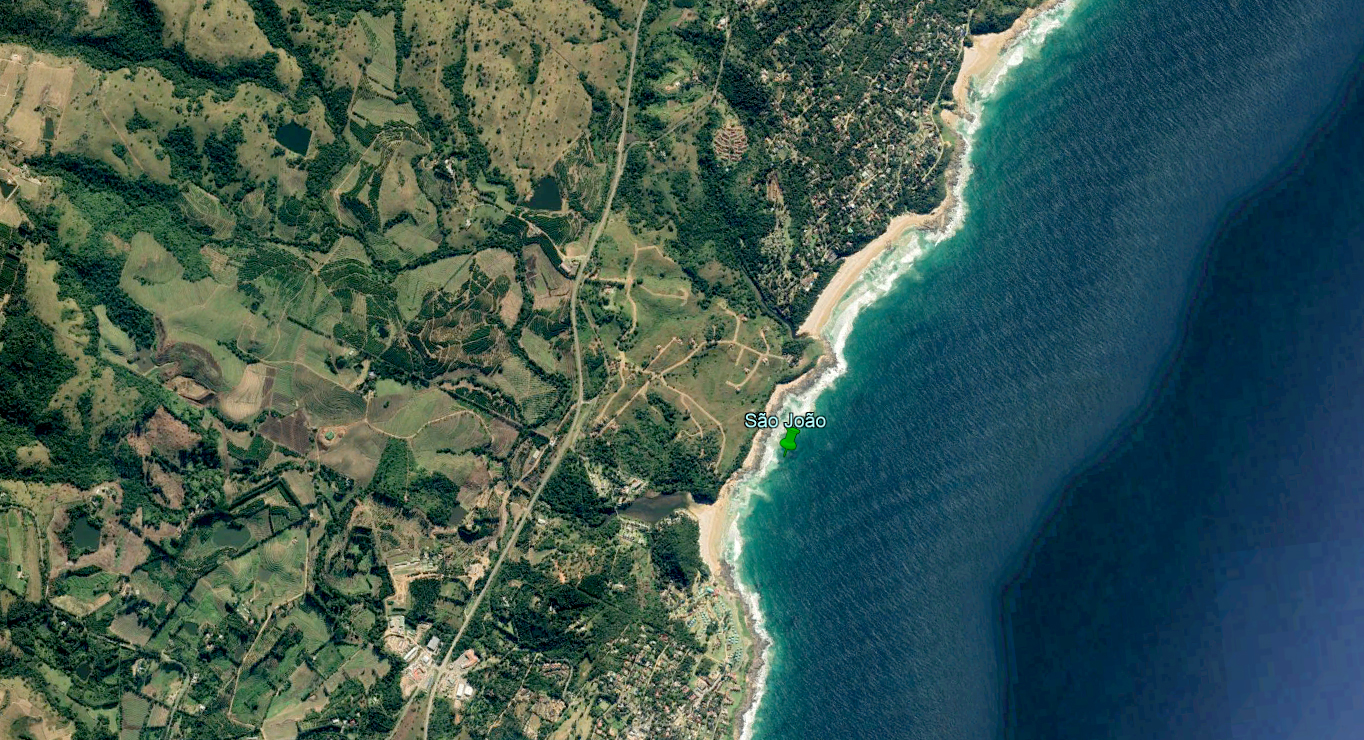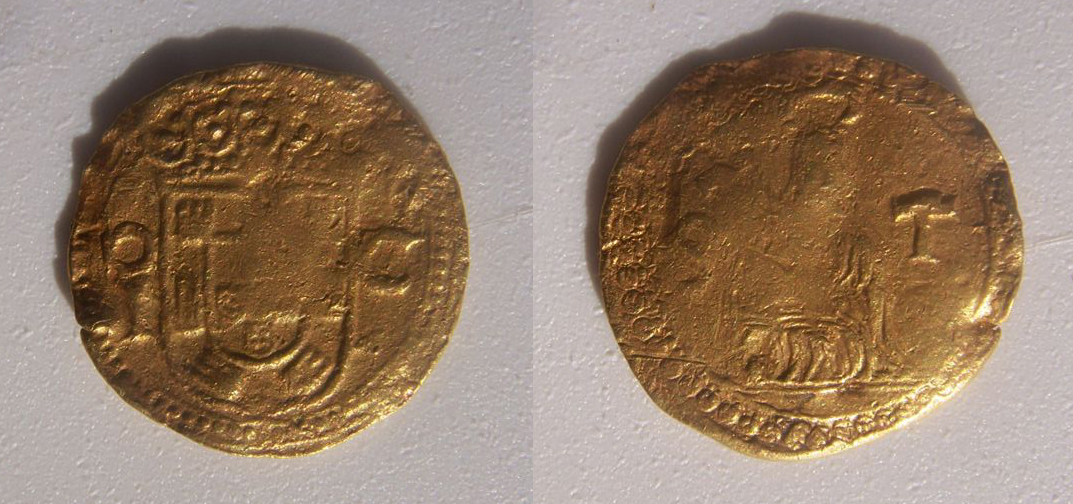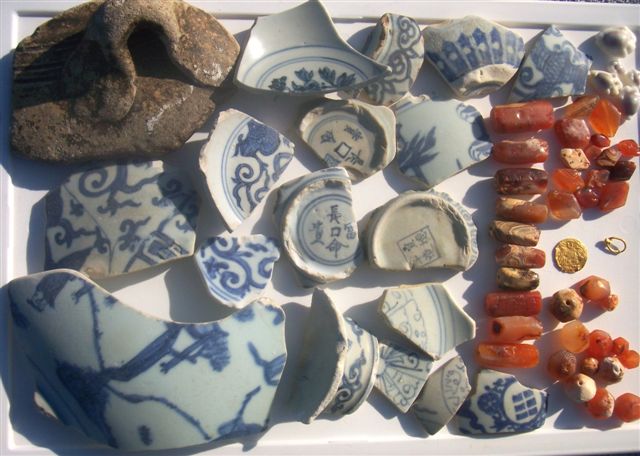São João Shipwreck (1552)
Filipe Castro, Chase Oswald, and Paulo Jorge Rodrigues
Country: South Africa
Place: Near Port Edward
Coordinates: 31° 02’S: 30 ° 14’E
Type: Great Galleon
Identified: Yes
Dated: 1552 (Historical accounts)
Introduction
The ‘great galleon’ S. João had a registered tonnage of 900 tons, and was one of the largest India Route naus built in its time. In the mid-1550s there were some attempts to build larger ships for the India Route but most sunk during storms. The account of this ship’s loss is included in the 18th century anthology História Trágico-Marítima , edited by Bernardo Gomes de Brito from a series of old shipwreck accounts.
The loss of S. João stands as one of the most popular stories of the period of Portuguese expansion overseas. It was built in 1550 in Lisbon’s shipyards, and lost in 1552 on her way back to Portugal before concluding her first voyage to India.

S. João left Cochin on 3 February 1552 under the command of Manuel de Sousa Sepúlveda with a load of 12,000 quintais of pepper, a substantial quantity of Chinese porcelain, and an enormous variety of drugs, spices, wood, and other exotic objects and fabrics. A heavy storm damaged the ship’s rigging and hurled it against the coast, eventually breaking the hull into three parts against the rocky bottom near today’s Port Edward in South Africa.

Of the more than 600 people aboard at least 120 persons perished. The survivors endured a grueling five and a half month march to the mouth of the Maputo River, during which the majority died of starvation, disease, or attacks from the indigenous populations. Out of the almost 500 people that undertook the march only 25 arrived at the Maputo River.

In 1980 a sport diver recovered part of a bronze gun from the place believed to be her wreck site.
The area was surveyed in 1983 by a team of sport divers who recovered many artifacts in spite of poor visibility, a difficult rocky bottom, and strong surf and current.
Some of the artifacts recovered were then offered to the Natal Museum, in South Africa, including the fragment of the bronze gun, shards of Ming porcelain from the Jiajing period (1522-1566), coarse earthenware, and glass beads from Cambay, India.
History
The original account of the São João was published anonymously in 1555-1564. According to Duffy, the ship’s shopkeeper, Alvaro Fernandes, told the story to the anonymous author in 1544; however, he admits there is much speculation around this statement.
On February 3rd, 1552, the Portuguese Galleon São João, captained by Manuel de Sousa began its homeward voyage from Cochin, India towards Portugal. The ship carried a fully loaded cargo including an inventory of around 7,000 quintals of pepper. On March 11th, the São João was sailing north-northwest, 25 leagues from the Cape of Good Hope, when she was assaulted by a storm from the west, forcing the crew to sail her close to shore to protect her cargo at all costs, as they had no sails to spare. The crew headed landward with the sails of the foremast half-furled, fearing they would lose foresail if it were used on its own. Approximately, 130 leagues from the Cape the wind changed to the northeast forcing the ship to turn south by southwest. Winds coming from both the east and the west caused the galleon to flood with so much water that she was on the verge of sinking. This storm continued for three days until it calmed, soon after the carpenter discovered that the storm had removed three pintles from the rudder putting the remainder of the voyage in grave danger. The captain ordered the condition of the rudder to be kept a secret aboard most of the ship as to not lower morale. Soon after strong winds tore the mainsail from the yard while the waves hit the ship with such force that they caused the rigging and beams on the port side to explode into pieces. In a desperate attempt to regain control of the ship the crew cut down the remains of the mast and yard to make a new mast on the stump from a section of a spar. On this, they attached yards to create a makeshift storm sail and foremast. However, this provisional set up was quickly destroyed by the wind while the waves soon tore away the rotten rudder. When the mainmast fell from its place it knocked the bowsprit over, lodging it inside the ship. Lacking a mast, sails, and rudder the crew desperately tried to head for shore.
The next 10 days were spent attempting to create a makeshift rudder from various parts of the ship, and sails from textiles. The new rudder proved entirely fruitless as the measurements did not fit the original and it was quickly lost to the sea. Luckily, land was finally sighted on June 8th and a small boat was swiftly taken on a scouting mission to find a safe area on which to lay anchor. The plan was to tie landlines from the shore to the ship and take a small boat in alternating trips, transporting passengers and cargo from the ship to the beach. From there they intended to build a temporary fort from barrels and build a small caravel from leftover ship parts to send a message to the closest Portuguese fortress at Sofala, on the East coast of Africa. However, after the third trip across, the São João began to slowly sink with only 30 people onshore. On the third day of the exodus, the pilot who was still onboard the São João noticed the sea line had been cut and it would not be long before the rest of the ship broke up against the coast. He and 40 others quickly boarded a lifeboat and sailed to shore where the boat crashed on the beach, while all the passengers landed without harm. At this point, more than 500 individuals were still on the ship, including 200 Portuguese and 300 slaves. From the shore, the ship was let out by the landline and allowed to drift towards the beach. As the ship went aground it first broke in two portions with one half from mast forward and the second from mast to the stern. Within an hour these two pieces became four, with the decks soon breaking up allowing the cargo to float towards the sea. The remaining stranded survivors clang to the floating wreckage, most made it to shore, though about 40 Portuguese and 70 slaves reportedly drowned in the process. It is estimated that the worth of the cargo to float towards the beach was at least 1,000 gold pieces. The ship was recorded to have wrecked on June 7th,1552 at 31° south.
Onshore there was not enough wreckage recovered to create a makeshift boat as originally intended; however, the survivors were able to build a fort from chest and barrels. The Portuguese stayed on the beach for 12 days before deciding to venture on as the wrecking of the ship was far from the end of the survivors suffering. Over the next five and a half months, approximately 80 Portuguese and 100 slaves would march an estimated 300 leagues, fording rivers and crossing marshes to reach salvation.
Although the shipwreck site is only 600 km from today’s Maputo, likely, the survivors walked at least twice that distance. During the march, many would die from starvation, dehydration, and skirmishes with the local tribes. The situation was so dire that at times the captain offered hundreds of cruzados to anyone willing to go off and find water. The goal of the party was to reach the river previously discovered by Lourenço Marques which emptied into Boa Paz as the survivors were sure to find passing Portuguese ships in this area. Along the march, the survivors ran into a mixture of friendly and fiendish native tribes. For instance, after ignoring the kindness of a benevolent indigenous king, who had warned them of the insidious nature of his neighbors, the latter supposedly tricked and robbed them of their possessions before stripping them naked. After such an event it was reported that the wife of the captain, Leonor de Sá, was so embarrassed that she buried herself in the sand and refused to move ever again, perishing in this spot. Not long after, the captain, Manuel de Sousa, was said to have wandered into the jungle and was never seen again. Both occasions post-date the prior abandonment of their child along the trek. All tragedies aside, the journey was not without its salvation, eventually eight Portuguese and 17 slaves had made it to their river destination and were rescued by a sailing Portuguese ivory merchant, who heard local rumors that there were Portuguese castaways in the land and ransomed out a search party to find them. By the 25th of May 1553, the survivors were finally safe as they reached Mozambique, months after the wrecking of the São João.
Team
In 1978, while investigating two potential wreck sites on the Transkei and southern Natal coast, Dr. Tim Maggs wrote to the East London museum requesting a loan of their blue and white porcelain collection from coastal areas in an attempt to determine dates for these sites. This spawned subsequent research into Portuguese-Indian literature and cultural material to aid in the identification and location of these wrecks. This research showed that the majority of the pre-1650 wrecks occurred during the ship’s homebound voyage, that most were Portuguese, and that some carried cargoes of Chinese blue and white porcelain. A plan was soon executed to perform a beach survey extending from the South African/Mozambique border (at latitude 26 ° 51’ south) to Plettenburg Bay (at latitude 34 ° 06’ south), searching for caches of Chinese blue and white porcelain and other potential shipwreck material.
In conjunction with this survey, Maggs also planned the inspection of related artifacts held in private and museum collections, the study of records of wrecks thought to have happened within his research area before 1650, the dating of recovered artifacts, and finally positive identification of cultural material from the wreck sites with wrecks described within the historical literature. Through this plan, the archaeology department of the Natal Museum in South Africa spent years collecting and recording ceramic sherds and carnelian beads that washed ashore in the vicinity of Port Edward on the Natal south coast around 31° 02’S: 30 ° 14’E. This investigation suggested that the site at Port Edward was the location of the wreck of São João. This initial identification was aided by the affirmation of the wreck location of the São Bento at the Miskaba site and the survivor’s account depicting their visitation to the wreck site of the São João. Maggs also used these historical accounts to trace the steps of the survivors of the São Bento to the wreck site of the São João. Furthermore, the porcelain fragments recovered from the Port Edward site were shown to have similar stylistic designs to those found on the Miskaba site Since no other shipwreck on the south-east African coast produced a similar style of porcelain dating to at least the 16th century, Maggs determined that São Bento and São João were the only shipwrecks in the region.
In 1980, L. Harris uncovered a bronze cannon while diving on the site near Port Edward. The discovery of this cannon was thought to have confirmed the location of the wreck of São João as the canon would not have been washed far from its original location. Further investigations to determine the location of the survivor campsite of São João took place between 2001-2002 by the University of Pretoria in which additional examples of ceramics, carnelian beads, pepper, and cowries were recovered from the coast.
Campsite
The primary objective during the reinvestigation of the São João wreck site by the University of Pretoria was the identification of the survivor campsite. To determine the location of the survivor campsite researchers used the historical accounts from the survivors of São João and São Bento, as the account of the São Bento’s loss mentions the location of the wreckage of the São João, gives superior geographic information, and is considered more reliable. Using the geographic context given within the survivor accounts of the São João and São Bento shipwrecks, in combination with accounts of campsites from other Portuguese shipwreck records, the researchers set out to determine potential campsite locations. They did so by creating a list of known campsite features to narrow down the geographic extent of the project and propose what may appear in the archaeological record. This list of common Portuguese shipwreck campsites comprised the 10 following characteristics:
- Never further than 1 km from the wreck, 2. Near water supply, 3. Survivors sought shelter, 4. Defensive structures were erected on flat surfaces, 5. Used material from wreck to build shelter, 6. The camp was divided into units, 7. Provisions were placed in the center of camp, 8. Survivors were divided into groups (in most cases into three groups), 9. Passengers were separated from the seaman, 10. A specific location was selected to bury the dead. (Burger, 2003: 94)
These efforts eventually lead researchers to narrow down the possible location of the survivor camp into five separate sites within the Port Edwards area. Archaeological surveys and excavations on each of the sites ensued and eventually, peppercorn was unearthed at one of the locations, most likely denoting it as being the position of the survivor camp. This site was located at 31° 02’ 18.0” S and 30° 13’ 52.9” E. Notably, this location held eight of the characteristics associated with Portuguese survivor campsites prescribed by the researchers.
True Porcelain
Among the porcelain, hemispherical bowls are common and many include motifs of dragons, lotus scrolls, pines, and wave borders. The dragon and lotus scroll depictions were typically found on small bowls with everted rims. A “diamond diaper border, known as a trellis, is also typically painted on the inside rims of these bowls and other porcelain vessels. Other notable borders on the rim sherds include motifs referred to as the “thundercloud” and the “classical scroll”. Among the true porcelain sherds, small foliate-rimmed dishes with interior “diamond-diaper borders” and exterior “floral scrolls” were recovered. Porcelain sherds determined to be base fragments contained motifs of “lions and ribbed balls”. Motifs among the sherds that were too damaged to be grouped with any particular form of vessel included patterns denoted as “floral”, “lotus panel border”, and a “curvilinear and dot border”. Among the porcelain sherds used to date the shipwreck the Taoist trigram motif proved invaluable, due to the heavy influence Taoism held during the reign of the emperor Jiajing 1522-1566. Of even greater interest were fragments containing inscriptions relating to “long life”, “riches and honor” depicted within the image of a coin; another inscription contained the character “Fu” which Maggs noted as most likely belonging to the phrase “Made at the Hall of Happiness and Good Fortune”. The principal porcelain sherds found among the collection are two sherds containing inscriptions of the name of Emperor Jiajing, firmly dating the sherds to a period between 1522 and 1566, as these are the only emperor reign-marks found in the collection.
Coarse Porcelain
The coarse porcelain found in the Port Edward area resembles the collection found among the wreck of São Bento in texture, color, glaze and pigment, brushwork, and motifs. Most of the vessels within this group are classified as small fluted dishes with foliate rims, while some are found undecorated most have motifs similar to the types mentioned among the true porcelain grouping. Within the center of these dishes’ motifs of the mythical animal, ‘ch’i-lin (Qilin), could be identified (fig 9). This type of dish is dated to the late 15th to 16th century and exported by Chinese manufacturers to South East Asia. Based on the foot rims it was determined that a range of sizes must have been present among this group of ceramics.
Earthenware
As with the porcelain recovered from this area, the earthenware was also deemed to be similar to the examples from the São Bento collection. The earthenware was denoted as being of course texture and fired at a high temperature. One sherd from the Port Edward collection is from a large jar with four strap handles, a type of ceramic that was also recovered from both the São Bento and the Santiago. Another contained stripes from a lighter colored clay implemented in a rectangular pattern similar to a jar from the Santiago wreck.
Guns
Part of a bronze gun was recovered. It is part of a breech loading gun commonly used in Portuguese ships of this period.


The remaining portion of the cannon measured 60 cm long with a barrel diameter of 6 cm at the breech. It was identified as a breech-loading swivel gun or part of the breech of a falconet. It is considered similar to the falconets found in the São Bento and Santiago wrecks, with measurements smaller than the guns recovered from these other ships. Upon reinvestigation of São João by the University of Pretoria, researchers contacted local salvors who claimed to have fragments from a small cannon and mentioned that there were still some cannons resting underwater in Port Edward. Another cannon held in the collector’s gallery at the Malan Museum was said to originate from the wreck of São João, as the museum owner states he purchased it from a restaurant owner in Port Edward; however, this cannon may instead belong to the São Bento as other information associated with it claims it was recovered from the Msikaba River which is where São Bento wrecked
Carnelian Beads
Carnelian beads are denoted as being made of semi-precious translucent agate, are either orange or red, and made of the mineral chalcedony. The beads played an integral role in currency exchange in the Mediterranean, India, Africa, and the Arab trade. The carnelian beads found in relationship to the Portuguese wrecks originate from Cambay, India, and were traded to West Africa in large quantities. Examples of these beads found among the São Bento and the Port Edward sites are denoted as being lozenge, bi-conical, or hexagonally shaped. Because they were traded over a long period, they were not considered helpful in ascertaining a date of the cultural material. Carnelian beads are significant among Portuguese shipwrecks in the 16th and 17th centuries because they are strictly associated with ships traveling on their homeward voyage back to Portugal. During later excavations by the University of Pretoria at the São João wreck site the largest bead measured 1.2 cm x 1 cm.
Cowries
During the reinvestigation of the site by the University of Pretoria, five cowrie specimens of Cypraea moneta were collected from the beach near the wreck site. As pointed out in Burger’s thesis, Cypraea moneta, or the money cowrie, grow in tropical water temperatures, most notably in the Maldive Islands; they have purple crowns and medium-sized teeth, with white unspotted bases and margins. This species is prevalent along the coast of Mozambique, found among marine vegetation and rock fissures; however, they are rarely found along the eastern coast of South Africa and are believed to primarily arise from the holds of shipwrecks in this area. The Cypraea moneta that washed up on the shores near Port Edward was useful in identifying the wreck site of the São João. The shells, between 1 and 1.5 cm in length, were sent to a lab to undergo light isotope analysis. The test proved that the Cypraea moneta collected were not indigenous to the area, and because these cowries are not present in the archaeological record in this area prior to the appearance of Portuguese merchants they must have been cargo on the São João.
Peppercorn
During the reinvestigation of the São João shipwreck by the University of Pretoria, peppercorn was found buried at one of the sites investigated near Port Edward. The survivor account from the wreck of São João states that the ship left Cochin with more than half the quantity of pepper the ship could carry and that an attempt was most likely made to salvage the cargo after the wrecking. The appearance of peppercorn during the reinvestigations most likely denotes that the Portuguese were active in this area meaning they most likely set up camp in this location.
Ballast
None reported.
Iron Concretions
No information.
Hull remains
No hull remains were reported.
Caulking
Not reported.
Fasteners
Not reported.
Size and scantlings
Just the tonnage, at 900 tons.
Wood
No timbers were reported.
References
Boxer, C.R., 2001, The Tragic History of the Sea, 1589–1622. 1958. Minneapolis: U of Minnesota P.
Brito, Bernardo Gomes de – História Trágico-Marítima, Ed. Afrodite, Lisboa.
Burger, E., 2003, Reinvestigating the Wreck of the 16th Century Portuguese galleon São João. Master’s Thesis, University of Pretoria, South Africa.
Duffy, J., 1955, Shipwreck & Empire. Cambridge: Harvard University Press.
Lanciani, Giulia – Os relatos de naufrágios na literatura portuguesa dos séculos XVI e XVII, , Lisboa, Biblioteca Breve, Instituto de Cultura Portuguesa, 1979.
Maggs, Tim – The Great Galleon S. João: Remains of from a mid-sixteenth century wreck on the Natal South Coast, in “Annals Natal Museum”, vol.26(1), Pietermaritzburg, December 1984, p. 173-186.
Quintela, Vice-Almirante Ignácio da Costa – Annaes da Marinha Portuguesa, nº.18-19, Lisboa, Colecções Documentos, Ministério da Marinha, 1975.
Sousa, Manuel de Faria e Sousa – Ásia Portuguesa, 6 volumes, Lisboa, Livraria Civilização, 1947.
Stuckemberg, Brian – Recent Studies of Historic Portuguese Shipwrecks in South Africa, Comunicação apresentada na Academia de Marinha em Junho de 1985, Lisboa, Academia de Marinha, 1986.
